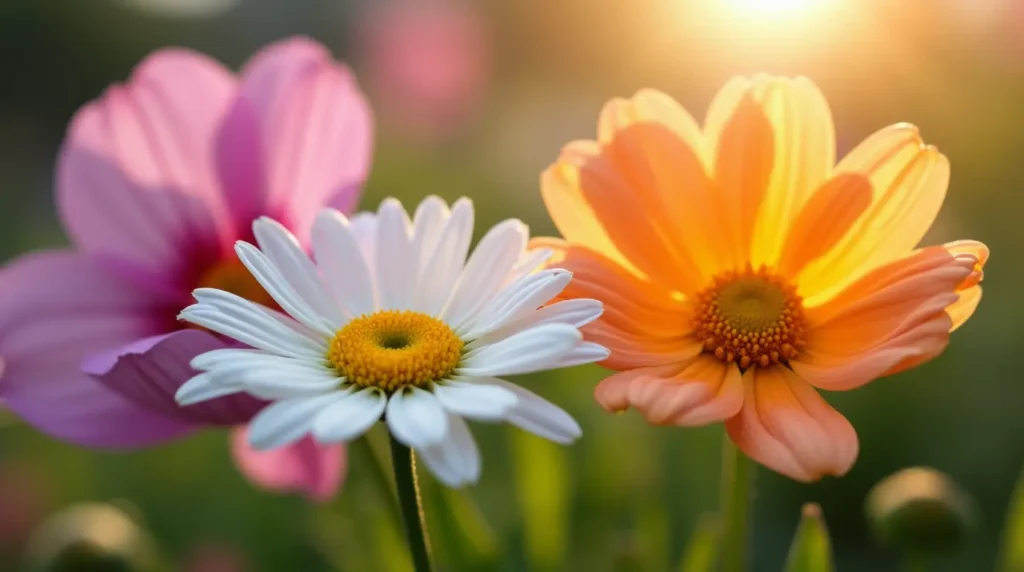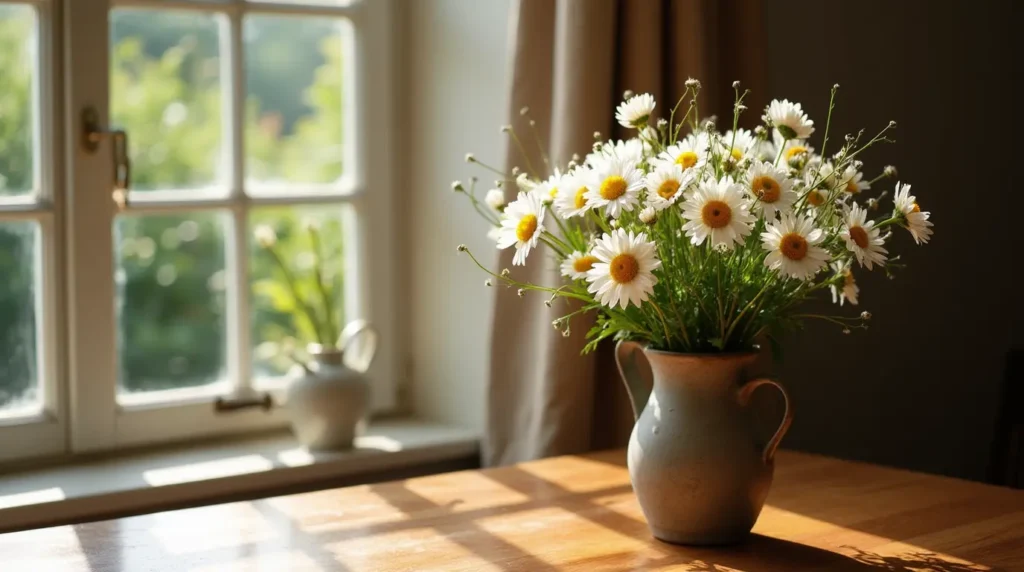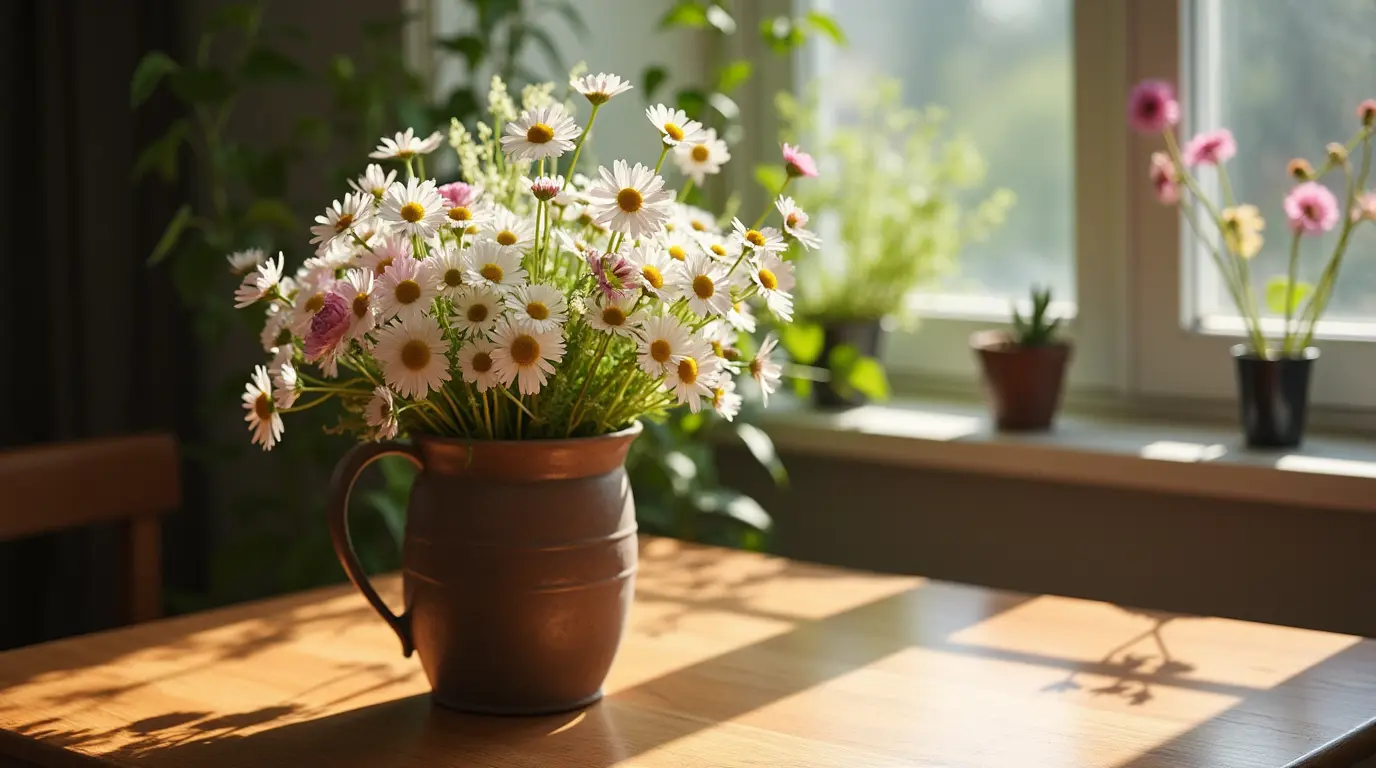Table of Contents
Spring brings vibrant colors with the April birth flowers, the daisy and sweet pea. These flowers symbolize April’s spirit and hold cultural significance. They are a favorite in gardens and floral arrangements.
This guide explores the history, symbolism, and care tips for these April flowers. It’s perfect for both experienced gardeners and beginners. You’ll learn how to make your April flowers bloom and brighten your space.
Key Takeaways
- Daisies and sweet peas are the official birth flowers for the month of April.
- These flowers hold significant cultural and historical meaning, representing purity, innocence, and new beginnings.
- Proper growing conditions, including soil, temperature, and support structures, are crucial for the successful cultivation of daisies and sweet peas.
- Understanding common pests and diseases affecting these flowers, as well as implementing preventive and natural treatment methods, is essential for their healthy growth.
- Proper watering, fertilization, pruning, and maintenance techniques can help ensure the longevity and vibrant appearance of your April flowers.
Understanding April Birth Flowers: Daisy and Sweet Pea Significance

As april flowers bloom, the april flower of the month has a rich history. The daisy and sweet pea hold deep symbolism and tradition.
Historical Meaning Behind April Flowers
Daisies symbolize purity, innocence, and loyal love. They were first honored in ancient Greece, dedicated to Aphrodite. Today, they represent loyal friendship and enduring bonds.
Sweet peas have a complex history. They were first grown in Sicily in the 17th century. In the Victorian era, they became a symbol of joy, departure, and new starts. This makes them a perfect choice for april flowers.
Symbolism in Different Cultures
- In Celtic tradition, daisies ward off evil and promote healing.
- In Japan, sweet peas symbolize happiness and gratitude, often given as a thank you.
- In Victorian England, sweet peas represented delicate pleasure and love, used to express hidden feelings.
Why These Flowers Represent April
The daisy and sweet pea are chosen for april flower of the month for good reason. They reflect the season’s vibrant energy. As spring arrives, these flowers symbolize hope and growth.
They represent loyal love, pure joy, and new beginnings. This makes them the ideal flowers for the month of april.
Essential Growing Conditions for Daisies
When growing april flowers or flowers for april, knowing what daisies need is key. These bright and cheerful april flowers need the right soil, sunlight, and temperature to bloom well. Gardeners must pay attention to these details.
Daisies love soil that drains well and is rich in nutrients. It should be slightly acidic, with a pH of 6.0 to 6.8. Adding compost or aged manure to the soil helps it grow strong. They also need lots of sunlight, at least six hours a day.
The best temperature for april flowers like daisies is between 65°F and 75°F (18°C and 24°C). They can handle cooler temperatures but struggle in very hot or cold weather. Remember, different daisy types might need slightly different temperatures.
- Soil: Well-drained, nutrient-rich, slightly acidic (pH 6.0-6.8)
- Sunlight: At least 6 hours of direct sunlight per day
- Temperature: 65°F to 75°F (18°C to 24°C)
By meeting these essential needs, gardeners can create the best spot for their april flowers. This ensures daisies bloom healthily and brightly all season long.
Sweet Pea Cultivation Requirements and Tips
For gardeners wanting to grow april birth flowers or april month flower, sweet peas need special care. Knowing the right soil, temperature, and support can help these fragrant flowers bloom well.
Ideal Soil Conditions
Sweet peas do best in well-drained, rich soil with a pH of 6.0 to 7.0. Adding compost or aged manure helps. It’s also key to prevent root rot by ensuring the soil isn’t too wet.
Temperature and Climate Preferences
Sweet peas love cool, mild weather, between 55°F and 70°F (13°C and 21°C). They need plenty of sunlight, about 6 to 8 hours a day. Protect them from too much heat to prevent them from drying out and growing too fast.
Support Structures for Sweet Peas
- Sweet peas climb, so they need strong support to grow well.
- Use trellises, fences, or netting for them to climb on.
- Put up the support before planting to help them grow upwards and bloom more.
By meeting the special needs of sweet peas, gardeners can enjoy a beautiful and fragrant display of these april birth flowers or april month flower outdoors.
Your Guide to April Flower Planting Seasons
Timing is key when planting april flowers like daisies and sweet peas. Knowing the best times to plant these april flower of the month varieties is crucial for a full bloom.
In cooler northern areas, plant daisy and sweet pea seeds in early spring, around March or April. This lets the plants grow strong roots before summer. In warmer southern places, you can plant a bit earlier, even in late winter.
Starting april flowers indoors is also an option. Sow seeds 4-6 weeks before the last frost date. This way, seedlings will be strong and ready for your garden.
Outdoor Planting Guide
| Climate Zone | Daisy Planting | Sweet Pea Planting |
| Northern/Cooler Climates | Early Spring (March-April) | Early Spring (March-April) |
| Southern/Warmer Climates | Late Winter (February-March) | Late Winter (February-March) |
Keep in mind, the perfect planting time can change based on your area’s weather. Always watch the frost forecast and adjust your planting schedule.
With the right timing, your garden will burst with color. Enjoy the beauty of april flowers all season long.
Common Diseases and Pests Affecting Daisies and Sweet Peas

Understanding common diseases and pests is key when caring for your april birth month flower and april birthflower. Both daisies and sweet peas face various issues. But, with the right steps and natural treatments, your plants can stay healthy.
Prevention Methods
Good garden hygiene is crucial to prevent diseases and pests. Regularly clean up fallen leaves and debris. Also, disinfect your tools. Make sure your plants have enough air and don’t overcrowd them to stop fungal infections.
Natural Treatment Solutions
Try natural remedies before using harsh chemicals. For powdery mildew on daisies, mix water and baking soda. Neem oil or insecticidal soap can fight aphids or spider mites on sweet peas.
Signs of Plant Distress
- Wilting or yellowing leaves
- Discolored or spotty foliage
- Stunted growth or lack of blooms
- Presence of pests, such as aphids or caterpillars
Watch your plants closely and fix problems quickly. This way, your april birth month flower and april birthflower will stay healthy and bright all season.
Watering and Fertilization Schedule for April Flowers
As the april birth flower and flower for april bloom, knowing how to water and fertilize them is key. This care helps these flowers grow strong and brighten your garden.
Daisies need moist soil but not too wet. Water them 1-2 inches a week, adjusting for weather. Sweet peas, however, like drier soil. Water them deeply once a week, letting the soil dry a bit before the next watering.
| Flower Type | Watering Frequency | Fertilizer Type | Fertilization Schedule |
| Daisy | 1-2 inches per week | Balanced, all-purpose | Every 4-6 weeks during growing season |
| Sweet Pea | 1 inch per week | High-phosphorus | Every 2-3 weeks during growing season |
Daisies do well with balanced fertilizer every 4-6 weeks in growing season. Sweet peas need high-phosphorus fertilizer every 2-3 weeks for their blooms to be vibrant.
By following these tips, your april birth flower and flower for april will get the care they need. They’ll bloom beautifully and make your garden a joy to behold.
Pruning and Maintenance Techniques
To keep your april flowers healthy and looking good, you need to prune and maintain them well. By using the right pruning and upkeep methods, your flowers will bloom brightly all month long.
Deadheading Methods
Deadheading is key to keeping daisies and sweet peas blooming. For daisies, just pinch off the old flowers. For sweet peas, cut the stems with sharp scissors right below the old flowers. This helps the plants make more flowers.
Seasonal Care Guidelines
- In early spring, cut daisies back a bit to help them grow bushy.
- During the peak of april, deadhead both daisies and sweet peas often to keep them looking neat.
- As autumn comes, start to water and fertilize less to help the plants get ready for sleep.
Growth Management Tips
To keep your april flowers in top shape, try these tips:
- Staking and Trellising: Use supports for climbing sweet peas to stop them from getting tangled.
- Pinching and Pruning: Trim the tips of daisies and sweet peas to make them bushy and full.
- Dividing and Transplanting: Every few years, split and replant daisies and sweet peas to keep them strong and growing well.
| Pruning and Maintenance Technique | Daisies | Sweet Peas |
| Deadheading | Pinch or snip off spent flower heads | Use clean, sharp scissors to cut stems below spent flowers |
| Early Spring Pruning | Prune back by a few inches to encourage dense, bushy growth | N/A |
| Staking and Trellising | N/A | Provide support structures to prevent tangling and sprawling |
| Pinching and Pruning | Pinch back growing tips to encourage branching and compact habit | Pinch back growing tips to encourage branching and compact habit |
| Dividing and Transplanting | Every few years to rejuvenate and promote vigorous growth | Every few years to rejuvenate and promote vigorous growth |
Indoor vs Outdoor Growing Considerations
Choosing between indoor and outdoor growing for april flowers like daisies and sweet peas depends on space, climate, and control. Knowing what each environment needs helps your april birth flowers grow well, whether indoors or outdoors.
Thriving Indoors
Indoor growing of april flowers has its perks, like controlling temperature and light. Daisies do well indoors because they love bright, consistent sunlight and moderate temperatures. Sweet peas need cooler temperatures and good air flow to grow indoors.
Flourishing Outdoors
Growing april birth flowers outdoors is rewarding if you have the space. Daisies and sweet peas love well-drained, rich soil and natural temperature and sunlight. But, outdoor plants need protection from pests and bad weather to thrive.
Deciding to grow april flowers indoors or outdoors depends on your preferences, resources, and plant needs. By understanding each environment’s needs, you can create the best conditions for your april birth flowers to bloom beautifully in your garden or home.
Companion Planting for April Flowers
Companion planting can change the game for growing april flower of the month and april month flower. By placing specific plants next to your daisies and sweet peas, you can gain many benefits. These benefits help your garden flourish.
One key benefit is pest control. For example, marigolds near daisies keep aphids away. Basil, on the other hand, keeps sweet peas safe from pea leaf weevils. This diversity makes your garden healthier and reduces the need for harsh chemicals.
| Companion Plant | Benefit |
| Marigolds | Repels aphids, attracts beneficial insects |
| Basil | Deters pea leaf weevils, enhances flavor |
| Nasturtiums | Attracts aphids away from daisies and sweet peas |
| Garlic | Deters spider mites and other pests |
Companion planting also boosts your april flower of the month and april month flower growth. Sunflowers or climbing vines support sweet peas. Alyssum, on the other hand, keeps the soil moist and weeds away from daisies.
By using companion planting, you can make your garden a vibrant and thriving space. With the right plants together, you’ll have a lush, healthy, and pest-free garden. It’s a beautiful way to celebrate april flower of the month and april month flower.
Using April Flowers in Floral Arrangements and Decor
The delicate beauty of april birth month flowers, like daisies and sweet peas, can brighten up any space. These flowers are perfect for adding a spring touch to your decor. They offer endless ways to create beautiful displays.
When working with april birthflower in arrangements, remember their special care needs. Daisies, with their bright white petals and colorful centers, look great with tulips and anemones. Sweet peas, with their soft, fragrant blooms, add a romantic feel to any bouquet.
- Cutting and Preserving April Flowers: Cut daisies and sweet peas at an angle, leaving a few inches of stem. Put them in clean water and chill until you’re ready to use them. Adding floral preservative can help them last longer.
- Displaying April Flowers: Place daisies and sweet peas in vases or jars. You can also use old teacups or mason jars. Group them for a full look or spread them out for a more subtle effect.
- Incorporating April Flowers into Decor: April birth month flowers are great for more than just arrangements. You can press them to make wall art or dry them for fragrant sachets or potpourri.
By using the natural beauty of april birthflower, you can welcome spring into your home. You’ll create stunning floral displays that celebrate the season.
Conclusion
Exploring April’s birth flowers, the daisy and sweet pea, has deepened our appreciation for their beauty. These flowers carry rich historical meanings and symbolize springtime renewal and joy across cultures.
Gardeners can now grow daisies and sweet peas with confidence. By understanding their needs, they can make their outdoor spaces vibrant and full of life. These april flowers add elegance and delight to any setting, whether in garden beds or floral arrangements.
As you continue your journey with flower for april, embrace the beauty and wonder of these plants. Take care of them, watch them grow, and enjoy the joy they bring. May your April flower journey be filled with excitement and appreciation.
FAQ
What are the two main April birth flowers?
The two main April birth flowers are the daisy and the sweet pea.
What is the historical and cultural significance of daisies and sweet peas as April flowers?
Daisies symbolize purity, loyal love, and new beginnings. Sweet peas represent blissful pleasure, adoration, and lasting memories. These flowers have been celebrated in various cultures as the essence of April.
What are the ideal growing conditions for daisies?
Daisies love well-draining soil rich in organic matter. They need full sun and temperatures between 60-75°F (15-24°C). Each daisy variety has its own needs, so research the specific requirements.
What are the key considerations for cultivating sweet peas?
Sweet peas prefer slightly acidic, well-draining soil and cool temperatures, 55-70°F (13-21°C). They need sturdy support to climb. Proper soil, watering, and fertilization are key for their growth.
When is the best time to plant daisies and sweet peas?
Planting times vary by climate zone. Daisies do well in spring or fall. Sweet peas are best in early spring or late fall, depending on your area.
What are some common diseases and pests that affect daisies and sweet peas?
Daisies and sweet peas face diseases like powdery mildew and pests like aphids. Use organic treatments and proper care to prevent these issues.
How should daisies and sweet peas be watered and fertilized?
Daisies need consistent, moderate watering. Sweet peas require more water, especially when flowering. Both benefit from balanced fertilizer at the start of the season and occasional feeding.
What are some effective pruning and maintenance techniques for daisies and sweet peas?
Deadheading is crucial for both to keep blooming. Seasonal pruning keeps them tidy and encourages growth. Staking or trellising also helps.
What are the key differences between growing daisies and sweet peas indoors versus outdoors?
Indoor growing requires careful attention to light and temperature. Outdoors, they get more natural light but face weather and pests. Knowing their needs is essential for success.
What are some beneficial companion plants for daisies and sweet peas?
Marigolds, lavender, and herbs like rosemary or thyme are good companions. They deter pests, improve soil, and enhance garden beauty.
How can daisies and sweet peas be used in floral arrangements and home decor?
They add beauty to bouquets and centerpieces. Their colors and delicate blooms bring spring to any space. Proper cutting and care extend their enjoyment.

